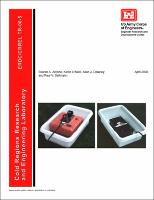Please use this identifier to cite or link to this item:
https://hdl.handle.net/11681/5465Full metadata record
| DC Field | Value | Language |
|---|---|---|
| dc.contributor | U.S. Army Environmental Center | - |
| dc.contributor | United States. Army. Office of the Chief of Engineers | - |
| dc.contributor.author | Arcone, Steven A. | - |
| dc.contributor.author | O'Neill, Kevin, 1946- | - |
| dc.contributor.author | Delaney, Allan J. | - |
| dc.contributor.author | Sellmann, P. V. (Paul V.) | - |
| dc.date.accessioned | 2016-03-21T16:37:40Z | - |
| dc.date.available | 2016-03-21T16:37:40Z | - |
| dc.date.issued | 2000-04 | - |
| dc.identifier.uri | http://hdl.handle.net/11681/5465 | - |
| dc.description | Technical Report | - |
| dc.description.abstract | Ground-penetrating radar (GPR) was used to detect UXO and non-ordnance on the 40-acre site (lot 54) of Jefferson Proving Ground, Indiana. The UXO are buried about 1 m deep in a clayey silt for which the soil water content ranged from moist near the surface to near saturation at about 1 m. A 16-bit radar was used to profile along previously established lines and transects over emplaced artificial targets. Data were recorded at 48Ð64 traces/s with minimal towing speeds during both dry and rainy weather. Target responses at both 300 (time range of 50 ns) and 600 MHz (30 ns) ranged from discrete diffractions to short reflection segments. Soil loss greatly attenuated diffraction hyperbolas. Theoretical analyses of these hyperbolas give an average soil dielectric constant of 10 at both 300 and 600 MHz. The phase polarity of many of the reflected and diffracted wavelets indicate targets with wave impedances higher than that of the soil. It is therefore assumed that these targets are metallic and the responses of some, whose locations correlate with the position of UXO on burial maps, are shown in detail. Theoretical modeling of wavelet propagation for this soil confirms the high rate of attenuation (47Ð66 dB/m round-trip), the maintenance of waveform, a shift in wavelet local frequency, and response to a typical UXO. It is concluded that GPR is effective for finding targets in this type of soil to no more than 2-m depth. It is recommended that future surveys utilize high trace acquisition rates to capture the full target responses, and a prowed, heavy dielectric antenna sled to improve antenna-to-ground coupling and to deflect surface obstacles such as vegetation. Broadband, three-dimensional numerical modeling of scattering from UXO-shaped targets in soil, with diverse orientations of antenna and target relative to one another, suggests that target length and diameter may be inferred from resonance patterns in backscattered signals. The simulations also reveal some ways in which oblique target/antenna orientations along a transect may affect frequency-dependent response patterns, providing clues as to target shape as well as positional ambiguities. | - |
| dc.publisher | Cold Regions Research and Engineering Laboratory (U.S.) | - |
| dc.publisher | Engineer Research and Development Center (U.S.) | - |
| dc.relation | http://acwc.sdp.sirsi.net/client/en_US/search/asset/1001565 | - |
| dc.relation.ispartofseries | ERDC/CRREL ; TR-00-5. | - |
| dc.rights | Approved for public release; distribution is unlimited. | - |
| dc.source | This Digital Resource was created from Microsoft Word and Adobe Acrobat | - |
| dc.subject | Dielectric constant | - |
| dc.subject | Unexploded ordnance (UXO) | - |
| dc.subject | Ground-penetrating radar | - |
| dc.title | UXO detection at Jefferson Proving Ground using ground-penetrating radar | - |
| dc.type | Report | en_US |
| Appears in Collections: | Technical Report | |
Files in This Item:
| File | Description | Size | Format | |
|---|---|---|---|---|
| ERDC-CRREL-TR-00-5.pdf | 937.69 kB | Adobe PDF |  View/Open |